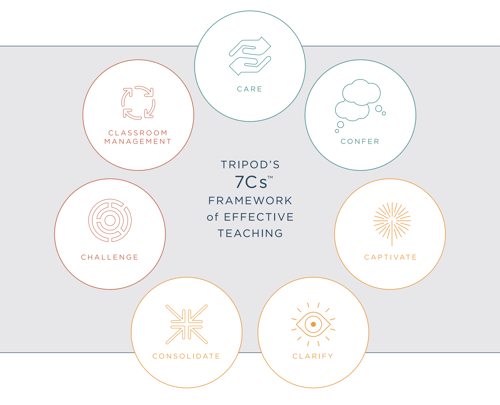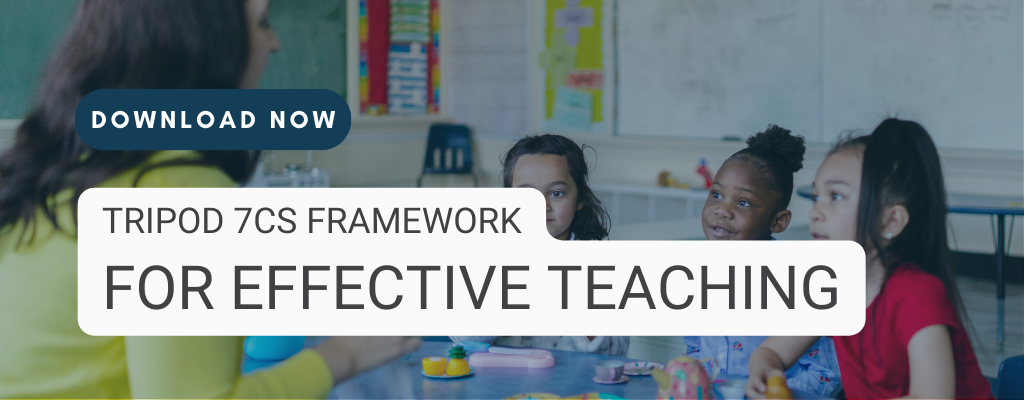
Seven reasons to include Tripod 7Cs in your Texas Teacher Incentive Allotment
7Cs Teaching Resources | 7Cs Practices
School districts face an increasingly competitive market as districts grapple over teacher talent. In Texas, the state implemented a grant system called the Teacher Incentive Allotment (TIA), where districts create criteria for designating “Master” teachers to reward their top performers.
For districts considering TIA, student perception data should be part of the performance evaluation tool because it’s tangible, scalable, and directly correlated to student achievement.
There’s a healthy debate to be made on the merits and pitfalls of performance pay in schools. But regardless of personal beliefs, TIA changed the game for Texas districts. The Governor directly referenced TIA in his press release after the Teacher Vacancy Task Force released its final report. It seems highly likely the state will use part of the historic surplus to fund TIA for the biennium.
I'm sharing seven reasons why you should consider student perception data as part of your TIA tool. I will use the Tripod 7Cs Framework of Effective Teaching as a validated system for collecting data.
Here’s a quick overview of the 7Cs Framework.
About the 7Cs Framework of Effective Teaching
Created through the Achievement Gap Initiative at Harvard University, The Tripod 7C Framework accurately measures and targets instructional improvements for classrooms nationwide. The tool does this through student perception data, administered through a 15-minute survey around seven competencies of an effective teacher:

When districts use the tool, they know it’s supported by a well-designed and well-implemented randomized control experimental study known as the Measuring Effective Teaching (MET) Study. Those research studies found the tool to be predictive for higher:
- student achievement,
- engagement, and
- motivation
There are several research papers tied to the 7Cs and their validity. Review all the data and research studies in this Education Elements and Tripod whitepaper. Let’s get to those seven reasons.
Reason 1: Increase the reliability of observation data
According to research studies, the 7Cs survey increases the reliability of observation data. These findings can apply to the TIA-required tools, including T-TESS, Danielson, or Marzano. As part of the Measuring Effective Teaching (MET) study, researchers found the reliability of student feedback to be higher than other measures. A follow-up study in 2019 also found the 7Cs composite score to be more reliable than observations and value-added test scores. When using all three tools - a growth measure from a standardized test, observational data, and student perception data - districts reduce volatility and create fairer performance measurement systems.
Reason 2: Give teachers more opportunities to shine
While observational data can give teachers an opportunity for principals to see their work in action, it’s not easy to increase the number of observations. Administrators only have so much time, and students’ perspective is valuable to teacher effectiveness.
With the 7Cs Student Perception Survey, you can easily administer the survey twice or thrice, giving teachers more consistent feedback to complement the observations and learning walks. Multiple administrations also give teachers time to grow within the school year. Because the reports we provide teachers include composite scores based on a normed data set, teachers receive fair scores that are normed against similarly composed classrooms.
Reason 3: Tie your Master Teachers to higher levels of student learning
High performance on 7Cs Framework associates with higher student learning, happiness, and college aspirations. When teachers challenge their students and create safe learning environments, students are more likely to achieve deeper levels of learning, meaning growth is more likely to happen.
Reason 4: Targeted action plans for teachers
After a district administers the 7Cs, Education Elements can partner with professional learning departments and principals to create targeted professional learning. Think of it like fitness training. The 7Cs Framework is like the “scale” or initial measurement of a teacher's performance. Working with Education Elements can be like working with a trainer so teachers can goal set, improve, and get closer to the Master teacher levels.
The instrument can identify longer-term holistic patterns, trends, and opportunities for improvement because it is based on student perceptions of support and academic press. Furthermore, principals and professional development leaders can quickly gauge how best to support their entire staff.
Reason 5: Measurable and relevant results for grades K-12, including core content CTE, and co-curricular subjects
Because the districts administering the 7Cs Student Survey come from student perception data, it represents the best teaching practices for all teachers, regardless of their subject or content area. Districts in TIA must adapt their growth measure to account for subjects not tested by the state. The 7Cs Framework creates a consistent metric across all teachers. Tripod offers different versions of the survey to make the data relevant from kindergarten through 12th grade, widening the impact. The 7Cs survey can be translated into multiple languages and distributed on paper or digitally.
Reason 6: Extend your investment
Setting your teachers on a continuous path to improvement pays non-monetary and monetary dividends that permeate the learning community. When teacher performance improves, so does student performance. As teachers become more successful, they are less likely to leave the profession.
The Learning Policy Institute estimates that a 50% reduction of 100 vacancies results in a savings of $550,000 for processing the exits and recruiting, onboarding, and training costs – savings that can be reallocated to support other high-priority areas of need.
So while everyone cannot be a Master Teacher, tools like the 7Cs Framework would benefit all teacher growth and support structures.
Reason 7: It’s simple
While the research behind the Tripod 7Cs Framework may be complicated, the reporting makes the tool simple. The aggregated 7Cs data provides principals and professional learning teams with patterns, trends, and common opportunities for improvement while the classroom-level data help leaders refine improvement strategies and provide personalized support to individual teachers. Unlike its competitors, the 7Cs provides aggregated data across many schools and the classroom level, enabling leaders to provide personalized support for their entire staff. Survey responses are analyzed at the classroom level and presented in user-friendly, online reports designed for teachers, school leaders, and district personnel. Reports highlight areas of strength and opportunities for improvement for each teacher, so teachers and leaders can quickly gauge where to focus attention.




